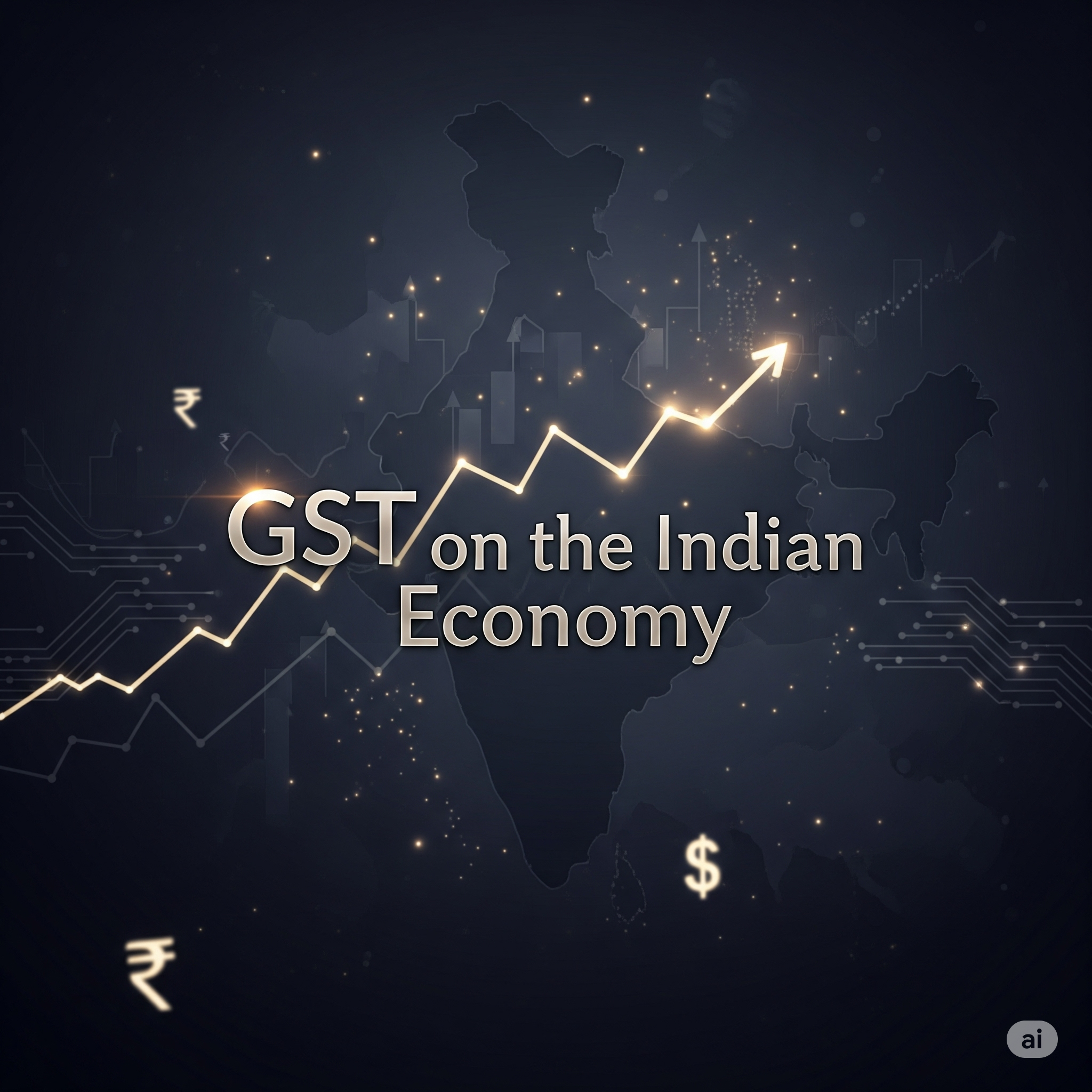Introduction
The Goods and Services Tax (GST), implemented on 1st July 2017, marked a historic reform in India’s indirect taxation system. It replaced multiple taxes levied by the central and state governments, creating a unified tax structure. GST is a destination-based tax levied on the supply of goods and services, designed to simplify compliance, reduce cascading taxes, enhance revenue collection, and boost economic growth.
GST has fundamentally transformed the Indian economy by integrating domestic markets, promoting ease of doing business, improving transparency, and formalizing unorganized sectors. This article provides a detailed examination of GST, its implementation, economic impact, advantages, challenges, and long-term implications for India’s growth.
Understanding GST
Definition and Structure
GST is a comprehensive indirect tax levied on the manufacture, sale, and consumption of goods and services. It subsumes various central and state taxes, including:
- Central Excise Duty
- Service Tax
- Value Added Tax (VAT)
- Central Sales Tax (CST)
- Luxury Tax, Entertainment Tax, Octroi, Entry Tax
GST is categorized into:
- CGST (Central GST): Collected by the central government on intra-state supplies.
- SGST (State GST): Collected by the state government on intra-state supplies.
- IGST (Integrated GST): Collected by the central government on inter-state supplies and imports, later shared with states.
GST Rate Structure
GST follows a multi-tier rate system:
- 0%: Essential goods (e.g., grains, milk)
- 5%: Essential services and goods
- 12% & 18%: Standard goods and services
- 28%: Luxury goods, sin products (e.g., tobacco, high-end cars)
Certain items like petroleum products, alcohol, and electricity are outside GST and taxed separately by states.
Objectives of GST
- Unification of Tax Structure – Replacing multiple indirect taxes to create a single market.
- Reduction of Cascading Taxes – Eliminate “tax on tax” effect, lowering the overall tax burden.
- Ease of Compliance – Simplified registration, return filing, and payment processes through online GST portal.
- Boosting Revenue Collection – Broadening the tax base and improving compliance to enhance government revenue.
- Promoting Formalization of Economy – Encouraging businesses to enter the formal economy and maintain proper accounting records.
- Facilitating Ease of Doing Business – Streamlined taxation reduces logistical hurdles and simplifies interstate trade.
Positive Economic Impact of GST
1. Boost to Economic Growth
GST has contributed to removing barriers between states, enabling seamless movement of goods and services. This has increased trade efficiency, lowered production costs, and enhanced overall GDP growth.
2. Expansion of the Tax Base
With mandatory registration for businesses above threshold limits, more enterprises, especially in the unorganized sector, have entered the formal economy. This has expanded the tax base and improved revenue collections.
3. Reduction in Logistics and Transportation Costs
Prior to GST, interstate trade involved multiple check posts and state entry taxes, causing delays and higher transportation costs. With GST, these hurdles have largely been removed, improving supply chain efficiency.
4. Encouragement of Formalization of MSMEs
GST encourages small businesses to maintain proper accounts and claim input tax credits, promoting transparency and accountability. Over time, this strengthens the MSME sector, which contributes significantly to GDP and employment.
5. Uniform Taxation and Ease of Business
GST has harmonized tax rates across states, reducing compliance complexities and enabling businesses to operate across India without multiple registrations.
6. Increased Revenue Collections for Government
- GST has stabilized revenue inflow for central and state governments.
- Higher compliance has increased direct and indirect tax revenues, enabling greater expenditure on infrastructure, social welfare, and economic development.
7. Promotion of Exports
GST allows zero-rated exports, meaning exporters can claim refunds on taxes paid for inputs. This reduces export costs and enhances global competitiveness of Indian goods and services.
8. Encouragement of Technology Adoption
GST compliance is digitally driven, with online registration, invoicing, filing, and payment. Businesses have adopted accounting software, ERP systems, and digital payment mechanisms, promoting a tech-enabled economy.
Challenges and Concerns with GST
Despite its transformative impact, GST implementation faced several challenges:
1. Complexity of Return Filing
Small businesses initially struggled with online filing and frequent return forms (GSTR-1, GSTR-2, GSTR-3B). Multiple revisions and frequent notifications added to compliance burdens.
2. Multiple Tax Slabs
India’s multi-tier GST structure (0%, 5%, 12%, 18%, 28%) created confusion among taxpayers and made compliance cumbersome, especially for MSMEs and traders.
3. Impact on Informal Sector
Small traders and businesses in the unorganized sector faced challenges in registering and maintaining records. Some were excluded or faced difficulties adapting to the digital compliance system.
4. Cash Flow Issues
Input Tax Credit (ITC) mechanism sometimes led to delays in refunds, creating cash flow problems, particularly for exporters and MSMEs.
5. State-Level Disputes
Some states raised concerns about revenue loss due to the initial GST compensation mechanism. Ensuring equitable revenue sharing has been a challenge.
6. Impact on Inflation
While GST reduced the tax burden on some goods, higher rates on certain commodities temporarily increased prices, affecting consumer demand.
Sectoral Impact of GST
1. Manufacturing Sector
- Benefits: Reduction in production costs, seamless interstate supply, and lower logistics costs.
- Challenges: Adapting pricing structures and IT systems for GST compliance.
2. Service Sector
- Benefits: Input Tax Credit allowed services providers to claim credit for GST paid on inputs, reducing cost of service delivery.
- Challenges: Certain services (like real estate before RERA integration) faced compliance hurdles.
3. MSME Sector
- Benefits: Access to formal credit, input tax credit, and increased market reach.
- Challenges: Compliance costs and digital literacy for GST filing.
4. Retail Sector
- Benefits: Simplified taxation, elimination of multiple state VATs, and improved pricing transparency.
- Challenges: Small retailers faced adaptation issues initially due to IT infrastructure requirements.
5. Export Sector
- Benefits: GST is zero-rated for exports, improving competitiveness.
- Challenges: Delay in refunds and documentation complexity affected small exporters.
GST and Its Macroeconomic Implications
1. Boost to GDP
Economic studies suggest that GST has contributed to 1–2% incremental GDP growth by enhancing efficiency in trade, reducing cost, and encouraging formalization.
2. Improved Tax Compliance
GST’s digital compliance framework has reduced tax evasion and enhanced accountability, improving government revenue without overburdening compliant businesses.
3. Inflation Control
GST has partially helped reduce the cascading effect of taxes, contributing to price stabilization for manufactured goods.
4. Investment Climate
Uniform taxation and streamlined compliance attract domestic and foreign investment, boosting industrial growth and employment.
5. Formalization of Economy
GST has encouraged many small businesses to register formally, improving financial inclusion and access to credit.
Case Studies
Case Study 1: MSME Sector Transformation
Small-scale textile manufacturers in Gujarat benefited from GST input tax credit, reducing production costs and increasing competitiveness in domestic and international markets.
Case Study 2: Logistics and Transportation
Prior to GST, interstate trucking faced multiple check posts causing delays and higher fuel consumption. After GST, the elimination of state entry taxes reduced logistics costs by approximately 20–25%.
Case Study 3: E-Commerce Sector
Online marketplaces like Flipkart and Amazon streamlined GST compliance through automated invoicing and taxation, enhancing market transparency and formalizing the e-commerce ecosystem.
Long-Term Implications of GST
- Enhanced Ease of Doing Business – A unified tax system reduces regulatory hurdles and improves India’s ranking in the World Bank Ease of Doing Business Index.
- Strengthened Formal Economy – Encouraging MSMEs and small businesses to formalize operations ensures a broader tax base.
- Revenue Stability for Governments – Stable GST revenue enables states and the central government to plan long-term development projects.
- Technological Adoption – Digital filing, e-invoicing, and automated IT systems encourage tech-driven governance and economic efficiency.
- Global Competitiveness – GST has lowered the cost of production, improving Indian goods’ competitiveness internationally.
Recommendations for Strengthening GST Impact
- Simplification of Compliance – Reduce forms and frequency of returns for small businesses.
- Single GST Rate Consideration – Long-term simplification to 1–2 slabs could reduce confusion and compliance burden.
- Timely Refund Mechanisms – Ensure exporters and MSMEs receive input tax refunds promptly to improve cash flow.
- Capacity Building – Training programs to enhance digital literacy for small business owners.
- Sector-Specific Adjustments – Periodic review of rates to ensure fairness and competitiveness in priority sectors.
- Technological Enhancements – Strengthen GSTN platform to handle high transaction volumes and reduce system downtime.
Conclusion
The implementation of GST represents a milestone in India’s economic reforms, transforming indirect taxation, boosting compliance, and promoting formalization. Its impact spans multiple sectors, including manufacturing, services, MSMEs, retail, logistics, and exports.
While challenges persist, such as compliance complexity, cash flow issues, and multi-slab structure, the long-term benefits outweigh initial hurdles. GST enhances efficiency, reduces the cascading tax effect, strengthens the formal economy, and improves India’s ease of doing business.
As India continues to evolve as a global economic powerhouse, GST will remain a key instrument in fostering growth, enhancing competitiveness, and ensuring inclusive and sustainable economic development. By addressing operational challenges and further simplifying the system, GST can drive India towards a more transparent, efficient, and resilient economy.




